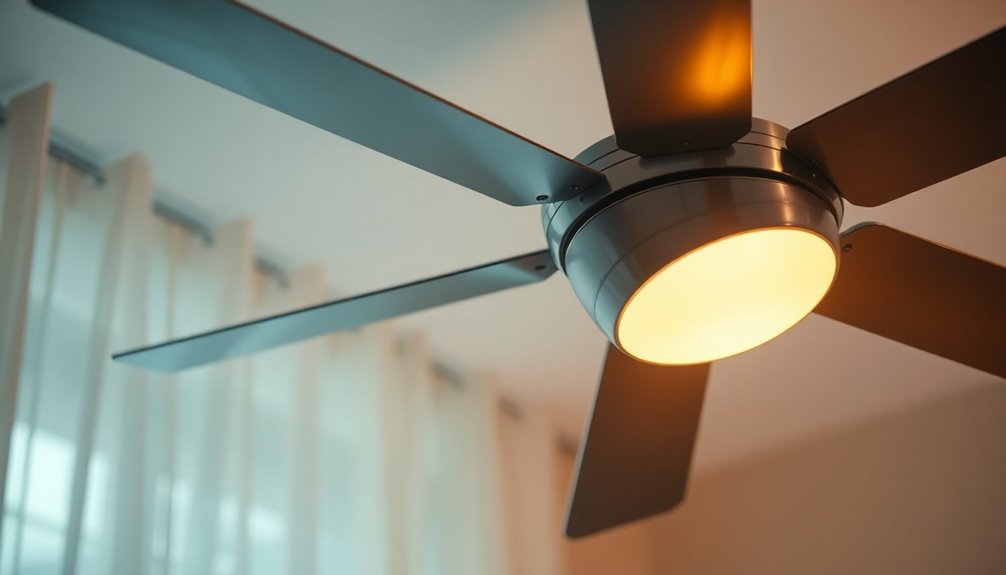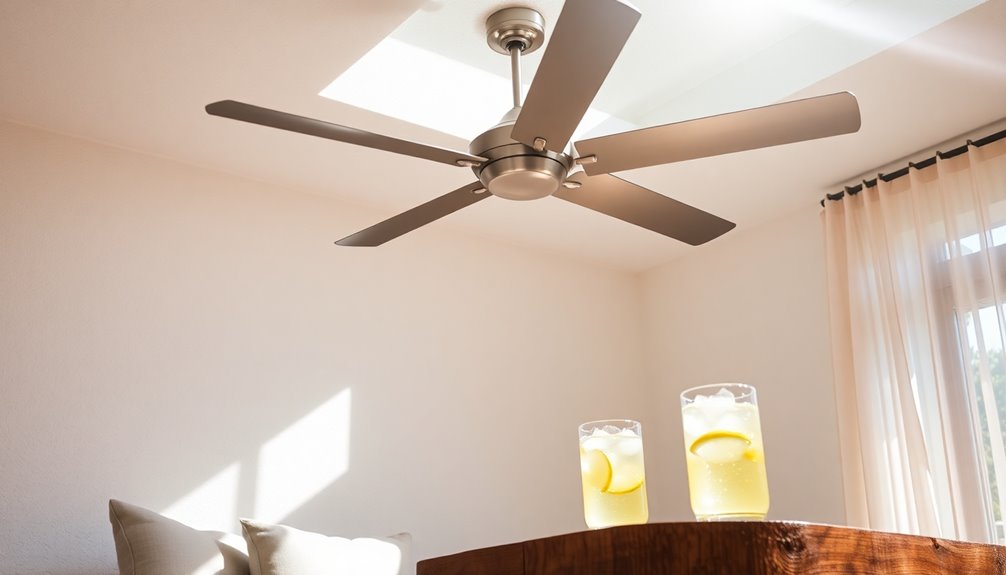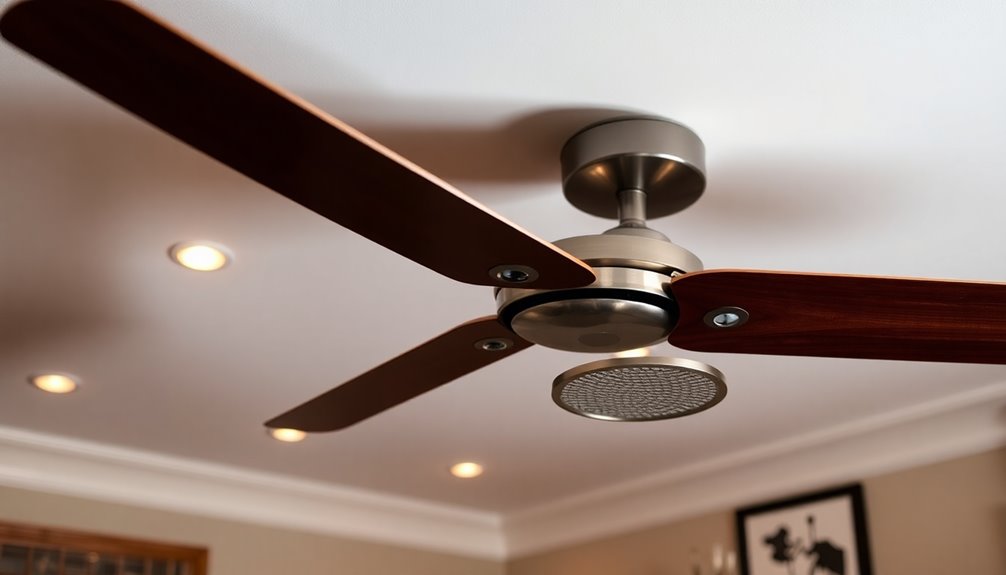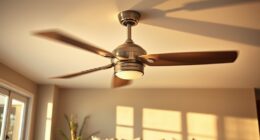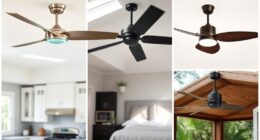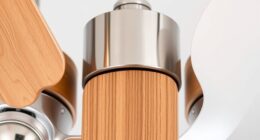To get the most out of your ceiling fan, adjust its direction by season. In summer, set it to rotate counterclockwise to create a cooling downdraft. This can lower your energy costs by up to 30%. In winter, switch it to clockwise at a low speed. This helps circulate warm air, potentially saving you around 15% on heating bills. Time your adjustments with Daylight Savings changes for maximum efficiency. Remember, each room may benefit from specific settings tailored to its use. If you're curious about those specifics and more tips, you'll find what you need just ahead.
Key Takeaways
- Set ceiling fans to counterclockwise in summer for a cooling breeze and energy savings of up to 30%.
- In winter, switch to clockwise at low speed to circulate warm air, potentially saving 15% on heating bills.
- Adjust fan direction during Daylight Savings Time changes for optimal efficiency—counterclockwise in spring and clockwise in fall.
- Ensure safety by turning off the fan completely before changing its direction using the reversing switch or remote control.
- Regularly clean fan blades and motor to maintain efficiency and extend the fan's lifespan.
Importance of Ceiling Fan Direction

The direction of your ceiling fan plays an essential role in your home's comfort and energy efficiency. Understanding ceiling fan direction can help you make seasonal adjustments that enhance airflow and optimize temperature perception.
During summer months, setting the fan to rotate counterclockwise creates a cooling downdraft, promoting airflow that helps reduce energy costs by up to 30%. You'll feel cooler without cranking up the AC.
In contrast, when winter rolls around, switching the fan to rotate clockwise generates an updraft that circulates warm air trapped near the ceiling. This simple adjustment can lower heating bills by 15% or more, making your home feel more comfortable without excessive heating.
Failing to adjust your ceiling fan direction may lead to inadequate airflow, resulting in discomfort and higher energy costs. By regularly changing the direction of your fan, you not only enhance comfort but also contribute to overall energy efficiency.
Seasonal Fan Direction Guidelines

Adjusting the direction of your ceiling fan according to the seasons can greatly enhance your comfort at home.
In summer, set your fan to rotate counterclockwise. This creates a cooling breeze that improves air circulation, making those hot days feel more bearable.
When winter rolls around, flip the ceiling fan switch to clockwise rotation at a low speed. This winter mode helps create an updraft, redistributing warm air without creating drafts.
By following these seasonal fan direction guidelines, you can enjoy significant energy savings:
- Up to 30% savings during summer
- 15% savings in winter
- Enhanced comfort levels year-round
- Reduced reliance on HVAC systems
- Ideal timing during Daylight Savings Time changes
Changing Ceiling Fan Direction

Changing your ceiling fan's direction is essential for optimizing airflow with the seasons.
To switch directions, first, turn off the fan and make sure it's completely stopped, then use the reversing switch or remote control, depending on your fan type.
Regularly adjusting the direction, especially during Daylight Savings Time, can help enhance your home's energy efficiency year-round.
Seasonal Adjustment Importance
Comfort in your home can be markedly enhanced by simply adjusting your ceiling fan's direction with the seasons.
By making these seasonal adjustments, you'll optimize airflow for both cooling and heating, ensuring that your comfort levels stay high year-round.
- In summer, set the ceiling fan direction to counterclockwise for a rejuvenating downdraft.
- Increasing thermostat settings by 4 degrees can reduce energy costs by up to 30%.
- In winter, rotate the fan clockwise at a low speed to promote warm air redistribution.
- This helps lower heating bills by 15% or more.
- Shifting to Daylight Savings Time is a perfect reminder to change your fan's direction.
How to Change Direction
To switch your ceiling fan's direction, start by making sure it's turned off and completely stopped for safety. This prevents accidents while you make adjustments. Depending on your fan type, the process varies.
| Fan Type | Direction Change Method |
|---|---|
| Pull Chain | Locate the reversing switch and toggle it to switch between clockwise and counterclockwise. |
| Remote-Controlled Fans | Make certain the remote is paired, turn off the fan, then press and hold the direction button until the light blinks. |
| Smart Ceiling Fans | Use compatible smartphone apps or voice commands for a convenient change. |
Once you've changed the direction, turn the fan back on to confirm it's operating in the desired rotation. For summer, you want it to rotate counterclockwise for ideal airflow, making the room feel cooler. In winter, switch to clockwise to help circulate warm air from your heating system, which can lead to energy savings. By understanding how to change the direction of your ceiling fan, you can enhance your comfort and efficiency throughout the year.
Timing for Direction Change

When it comes to changing your ceiling fan's direction, timing is key.
You should adjust it during Daylight Savings Time—switch to counterclockwise in spring for cooling and clockwise in fall for heating.
Making these biannual changes not only keeps your space comfortable but can also help lower your energy bills. Additionally, ensuring that your ceiling fan is set to the correct direction can improve air circulation and comfort levels throughout your home.
Daylight Savings Time Adjustment
As Daylight Savings Time approaches, you should take the opportunity to adjust your ceiling fan's direction.
This simple switch can make a big difference in your home's comfort and energy efficiency. When you spring forward, set your fan to rotate counterclockwise to promote summer cooling. This creates a pleasant breeze that enhances airflow, keeping your comfortable home cool.
In the fall, when the clocks fall back, switch the fan to rotate clockwise to distribute winter warmth efficiently.
Here's a quick checklist to guide you through these adjustments:
- Spring Forward: Change to counterclockwise for cooling.
- Fall Back: Switch to clockwise for warmth.
- Energy Savings: Reduce energy costs by optimizing airflow.
- Complement HVAC Systems: Work in harmony with your heating and cooling systems.
- Regular Adjustments: Keep your home consistently comfortable year-round.
Seasonal Direction Changes
Adjusting your ceiling fan's direction seasonally is essential for maximizing comfort and efficiency in your home.
The best times to make these seasonal direction changes are during Daylight Savings Time adjustments, making it easy to remember each spring and fall. When you spring forward in March, set the ceiling fan to rotate counterclockwise. This direction enhances air movement, helping to circulate cool air and prepare your home for the hot summer months.
Conversely, when you fall back in November, switch the fan to rotate clockwise. This change aids in heating your living spaces by pushing warm air down, improving comfort during the chilly winter months.
Always verify the fan is turned off before making direction changes to prevent damage and guarantee safe operation.
Ceiling Fan Direction by Room

Choosing the right ceiling fan direction for each room can greatly enhance comfort and efficiency. The direction you choose impacts airflow, air circulation, and overall room comfort.
Here's how to adjust your ceiling fan based on the room type:
- Dining Rooms: Set the fan to rotate clockwise at medium or low speed. This prevents your food from cooling too quickly while still promoting air circulation.
- Home Offices: Use a medium-speed clockwise setting to avoid blowing papers around, ensuring a comfortable working environment.
- Vaulted Ceilings: Keep the fan on counterclockwise year-round. This minimizes the wind chill effect and maintains comfort.
- Rooms with Smokers: Opt for a clockwise setting. This draws warm air and smoke upward, enhancing ventilation, especially when windows are open.
- Outdoor Areas: Always set outdoor fans to counterclockwise at high speed. This creates a rejuvenating breeze and helps manage insects.
General Ceiling Fan Tips

Maintaining your ceiling fan's performance is key to enjoying its benefits. To maximize efficiency, make certain your ceiling fan is installed 7-9 feet above the floor and at least 10 inches from the ceiling. This setup allows for ideal airflow and helps cool air circulate effectively.
Remember that ceiling fans don't actually cool a room; they create a wind-chill effect that enhances comfort.
To get the right ceiling fan direction, set your fan to rotate counterclockwise during warmer months. This will create a cool breeze and distribute heat more evenly during colder months by reversing the fan direction to clockwise. This change can help push warm air trapped near the ceiling downwards, improving comfort and energy savings.
Regular cleaning of the fan blades and motor is essential for maintaining efficiency and reducing energy consumption.
If you have a larger room over 500 square feet, consider installing multiple fans to make certain consistent air distribution. Using a remote control or smart technology can simplify the operation, making it easy to change ceiling fan settings as needed.
Ceiling Fan Installation and Maintenance

Installing and caring for your ceiling fan correctly is essential for maximizing its performance and longevity. Start by verifying proper ceiling fan installation. Aim for a fan height of 7-9 feet above the floor to guarantee ideal airflow. Maintain a minimum clearance of 10 inches between the blades and the ceiling, and at least 18 inches from walls to enhance airflow and prevent obstructions.
Here are some key tips for effective installation and maintenance:
- Use a down rod for vaulted ceilings to achieve appropriate fan height.
- Regularly check and tighten screws and bolts to guarantee safety and performance.
- Utilize a leveling tool for proper blade alignment.
- Clean the blades and housing periodically to maintain efficiency.
- Monitor the fan's operation, listening for any unusual noises that may signal maintenance needs.
Frequently Asked Questions
How Do You Tell if a Fan Is Going Clockwise or Counterclockwise?
To tell if a fan's going clockwise or counterclockwise, stand directly underneath it and watch the blades. If they move from left to right, it's rotating clockwise.
For counterclockwise, the blades create an upward breeze, giving you a cooling effect.
You can also check for a reversing switch on the fan or use a remote control; pressing the direction button will indicate the rotation, often with a blinking light confirming the change.
What Is the Correct Way for a Ceiling Fan in the Summer?
In the summer, you should set your ceiling fan to rotate counterclockwise.
This direction creates a cooling downdraft, enhancing your comfort by producing a revitalizing wind chill effect.
By running it this way, you can actually reduce your energy costs, allowing you to raise your thermostat by about 4 degrees.
Just stand under the fan to feel the cool air and verify it's working efficiently for those hot days.
What Direction Should I Face My Fan?
Imagine standing in a warm room, wishing for a gentle breeze to cool you down.
When it comes to facing your fan, you want it to create that invigorating airflow. In summer, direct it counterclockwise for a cooling downdraft.
In winter, switch it to clockwise at low speed to circulate warm air.
Adjusting the direction can save you up to 30% on cooling costs and 15% on heating, making your home more comfortable.
Which Way Should a Ceiling Fan Turn in Summer Reddit?
In summer, your ceiling fan should turn counterclockwise. This direction creates a cooling downdraft, making your space feel more comfortable by enhancing airflow.
You'll notice the breeze helps cool your skin, allowing you to set your thermostat higher and save on energy costs. To check if it's rotating correctly, stand under the fan and feel for the airflow coming down.
Most fans have a switch to easily change the direction if needed.
Conclusion
So, whether you're basking in the summer sun or cozying up during winter's chill, adjusting your ceiling fan's direction is a breeze! Embrace the gentle flow of air to keep your space comfortable year-round. Remember, a little tweak here and there can make a world of difference in your home's vibe. With a bit of care and attention, your ceiling fan will be your trusty companion, ensuring every season feels just right. Happy fanning!
